
DEVELOPMENT ACTIVITIES
3. Activities to help develop gripping, reaching, and
hand‑eye coordination
305
Most babies are born with
a ‘grasping reflex’. If
you put your finger in
their hand, the hand
automatically grips it—
so tightly you can lift
up the child.
Usually this reflex goes away, and gradually
the baby learns to hold things and let go as she
chooses.
Babies who are slow to develop sometimes have
little or no ‘grasping reflex’ and are slow to learn
to hold things. For such children, these activities
may help.
If she keeps her hand closed, stroke the outer
edge of the hand from little finger to wrist.
This often causes the baby to lift and open
her hand, and to grip your finger.
CAUTION: In a child with spasticity, stroking the
back of the hand may cause her to grip or open the
hand stiffly without control. If so, do not do it,
but look for ways that give her more control.
NO!
cp
When the child opens her hands well, but has trouble holding on,
place an object in her hand, and
bend her fingers around it. Be sure
the thumb is opposite the fingers.
Gradually let go of her hand and
pull the object up against her
fingers or twist it from side to
side.
When you think
she has a firm
grip, let go.
Repeat several
times in each
of the child’s
hands.
After the child can hold an object placed in her
hand, encourage her to reach and grasp an
object that just touches her fingertips.
First touch the top of her hand—then place
it below her fingertips.
Encourage the baby to grasp by offering her
rattles, bells, colorful toys, or something to eat on
a stick.
Hang interesting toys,
If the child
bells, and rattles where
shows no
the child can see and
awareness
reach for them.
of her hand,
hang little
This way the
bells from
child learns to
her wrist.
move her hand
forward to take
hold of a toy.
Also, see p. 327 for ways to help a child discover her hands by putting a sweet food on
her finger and helping her take it to her mouth.
disabled village children